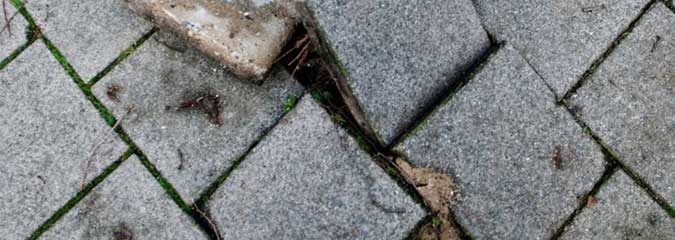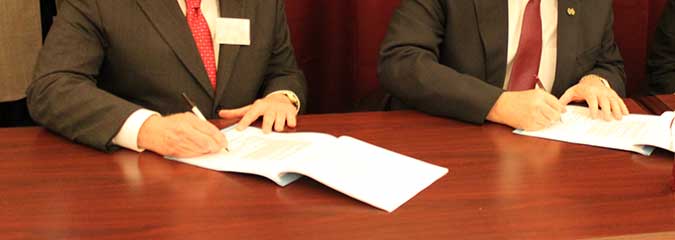
Slips, Trips & Falls
At first glance, slipping and falling may seem like a fairly trivial matter, particularly if you happen to be young and fit. Indeed, on most occasions, if you happen to trip over a protruding paving stone or slip on a patch of ice, the chances are that you’ll be able to pick yourself up, dust yourself down and move on, with little more than a badly bruised ego.
Even if you’re in relative good health, however, a slip trip or fall can still result in serious injury such as painful bruising, broken bones and whiplash, whilst any older people who fall run the serious risk of suffering a major injury such as a broken hip or badly damaged back. In either of these cases, it’s clear that what may seem, at first, to be a trivial incident can have long term ramifications, causing pain and distress and impacting upon your ability to live a full life and earn a living.
If the slip or fall was simply an accident, of course, then there’s little you can do except cruse your bad luck and hope for a full recovery. If, on the other hand, you slipped or tripped because someone else was negligent, then you may be able to make a claim for compensation. If you stumbled over a badly maintained pavement, for example, or slipped on a spillage in a supermarket aisle, then the fact that someone somewhere hasn’t done their job properly has been directly responsible for your injuries, and so it’s only right that this should be recognised, both as a mark of what you’ve been through and to ensure you don’t end up out of pocket as a result of your injuries.
For a glimpse of the scale of the problems presented by slips, trips and falls, the following are some of the statistics collating the numbers of people who were admitted to hospital in England following a trip or fall during the year up to February 2013, as reported by the Health and Social Care Information centre:
- Falls caused by slipping, tripping and stumbling – 89,488
- Falls involving snow and ice – 6,178
- Falls or trips with the cause listed as ‘unspecified’ – 148,308
Alongside these figures is a breakdown of the types of injury most likely to occur as the result of such a fall:
- Fracture of femur – 60,987
- Fracture of forearm – 37,424
- Open head wound – 34,801
Even a cursory glance at these figures, bearing in mind that they only cover people who were badly injured enough to require hospital admittance, reveals both the extent of the problem in terms of those effected and it’s seriousness given the type of injury involved. If you’re injured in this manner because some other party made a mistake, then it’s only fair that you should be able to seek compensation to allow you to start getting on with the rest of your life.
A successful claim will involve demonstrating that you’ve been injured by your fall, and then showing that it only took place because of the other party’s negligence. Putting together a case capable of clearly showing both of these things will be the job of your personal injury lawyer, who will work without any up-front fee to build a compelling picture of the extent of your injuries, the neglect which caused them, and the effect – physical, psychological and financial – that this has had on you.

Tripping on a Pavement
If you trip over on a public pavement, and feel that your fall was caused by the fact that the pavement in question had been left in an unsafe condition, then any claim for compensation you make should be directed toward the Local Authority responsible for the upkeep of public spaces in the area. According to the Highways Act of 1980, the local authority has a duty to check their pavements on a regular basis and to ensure that they are free from both obstructions and anything else which would present a risk to pedestrians.
If, on the other hand, you trip whilst walking on a path which is situated on private land, the negligent party will be seen as the person or body who owns the land.
The complication inherent in launching any claim following a trip or fall is the fact that there is no precise legal definition of a ‘dangerous pavement’ or a ‘pothole’. Whilst no such definition exists it is left to precedent and case experience to establish the definition, and the study of cases based on dangerous pavements has led to a general acceptance that any paving stone which protrudes by more than an inch will be regarded as ‘dangerous’. This is only a general guide, however, and your personal injury lawyer will be able to advise as to whether there is a case to answer in your own particular circumstances.
A similar situation pertains where potholes are concerned, in that there is no standard definition of what constitutes a pothole but, according to the Highways Maintenance Efficiency Programme Pothole Review, published in 2011, a general definition arrived at by looking at the behaviour of Local Authorities throughout England is as follows:
a) Pothole on footpath – 75mm diameter by 20mm depth
b) Pothole on road – 250mm diameter by 40 mm depth
In either case, it is vital that you gather evidence of the condition of the pavement, footpath or road as quickly as possible. If you are able to do so, take a photograph of the scene, using an object such as a coin to give a sense of scale.

Making a Claim
If you feel that you’ve been injured because someone was negligent in their treatment of a pavement or road, then you have every right to make a claim. According to the Highways Act, the responsibility for maintaining roads and pavements rests with the local authority, and for your claim to be successful you have to demonstrate that the authority concerned had sufficient time and opportunity to repair the surface in question.
The first thing to do in the aftermath of an accident is to record as many details as possible, including the size and placement of the defect. If you can, measure and photograph it, and take down the names and details of any witnesses to your accident. In order to make your claim official, put in a complaint to the relevant authority, and also seek medical treatment at the earliest possibility. This will have the combined effect of ensuring any injuries are treated and establishing an official record of the accident.
One of the major planks of any compensation claim following a trip whilst walking on a pavement, footpath or road, will be establishing that it would be reasonable of you to expect that the responsible party should have noted and dealt with the fault before it caused you to trip. Whether it’s a pothole or an uneven paving stone, a claim will only be successful if you can demonstrate that the relevant party had been informed of the problem, or ought to have spotted it, and had made reasonable attempts to deal with it.
You have the legal right to put a Freedom of Information request into your Local Authority, under which they will be duty bound to disclose how often the pavement or road is inspected and whether the authority had indeed already been informed of the problem.

Tripping in a Supermarket
If you fall and injure yourself in a private place such as a supermarket, train station or shopping mall, and the fall was caused by an act of negligence such as a floor being left in a wet state or some debris not being cleared away, then you can make a claim for compensation against the owners. According to the Health and Safety Executive the owners of a private space have a duty to ensure that all surfaces underfoot are cleaned, monitored and maintained in a manner which ensures the safety of customers, visitors and staff. This means that anything spilled on the floor should be cleaned immediately, any floor left wet through this cleaning should be dried, if a floor can’t be dried it should have prominent ‘Wet Floor’ warnings in place, objects which might cause people to trip (loose wires, machinery, stock etc.) should be cleared away and the floor itself should be maintained in excellent condition, with any badly worn or damaged areas brought clearly to peoples’ attention.
If you injure yourself by falling in a public place, then the case for your compensation claim should include the following:
- An entry in the organisations’ accident book.
- The accounts of any witnesses.
- The records of any medical treatment required.
- If you can, take a photograph of the problem which caused your fall.
- There’s a chance that the trip may have been caught on CCTV. You can obtain this footage from any public body via a Freedom of Information request.

Falls on Snow and Ice
Although it’s possible to slip over a damaged or uneven walking surface at any time, the number of people suffering trips and falls serious enough to warrant hospital treatment tends to rise in the winter, due to the hazardous nature of snow covered and frozen pavements and walkways. If you slip in this manner the temptation may well be to simply write it off as bad luck, but the truth is that your Local Authority has a legal obligation to keep your roads and pavements safe, and at certain times of the year this includes taking all reasonable steps to remove snow, ice and other hazardous surfaces.
Similarly, the private owner of a space such as a business has a legal obligation under the Occupiers’ Liability Act 1957 to ensure the safety of any visitors to the property, something which includes making reasonable efforts to ensure visitors don’t slip on icy walkways. (Source: http://www.legislation.gov.uk/ukpga/Eliz2/5-6/31/contents)

Claims Portal
Since 2010, claims for injury in a public place which are covered by public liability and have a value of £25,000 or less have to be processed through the Claims Portal, an online electronic interface set up by the Ministry of Justice (See: http://www.claimsportal.org.uk/en/). The portal will allow your representative to input all of the details of your case in a manner which is quick, efficient and secure.
By speeding up communications and the sharing of information, it is hoped that the portal will deal with uncontested claims much more quickly than the Court system, thus saving the claimant time and money. Whilst a body may at first deny any liability, the prospect of having to contest a clear cut case will often lead to an offer to settle, and will have the added plus point of helping to cultivate and encourage safer conditions in the future.
Although all cases are processed on a no win no fee basis, some costs could be payable under certain circumstances. Any costs would be fully explained upfront by your solicitor before you decide to proceed with your claim. Termination fees may apply based on time spent on your case, or in situations such as: lack of cooperation, deliberately misleading your solicitor, failing to attend scheduled medical or expert examinations, or not appearing at a required court hearing.
By submitting your details into the contact forms provided, you agree to be contacted by National Accident Helpline (a brand of National Accident Law, a firm of personal injury solicitors regulated by the Solicitors Regulation Authority) to discuss your claim.
NoWinNoFee.org is a trading name of Colour Ventures Ltd. Colour Ventures Ltd is regulated by the Financial Conduct Authority in respect of regulated claims management activities. Registration is recorded on the website https://register.fca.org.uk
Colour Ventures Ltd registered office address: Flannigan Edmonds Bannon, Linenhall Exchange, 1st Floor, 26 Linenhall Street, Belfast, BT2 8BG. Company registration number: NI070913



